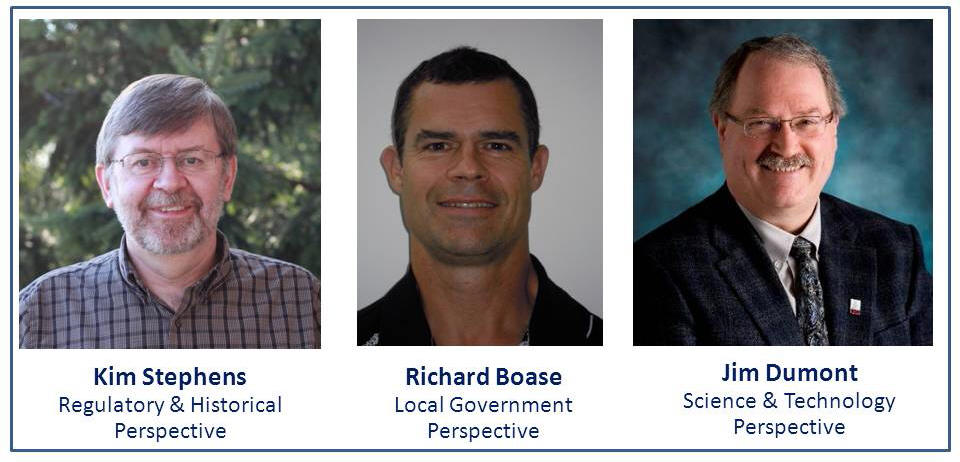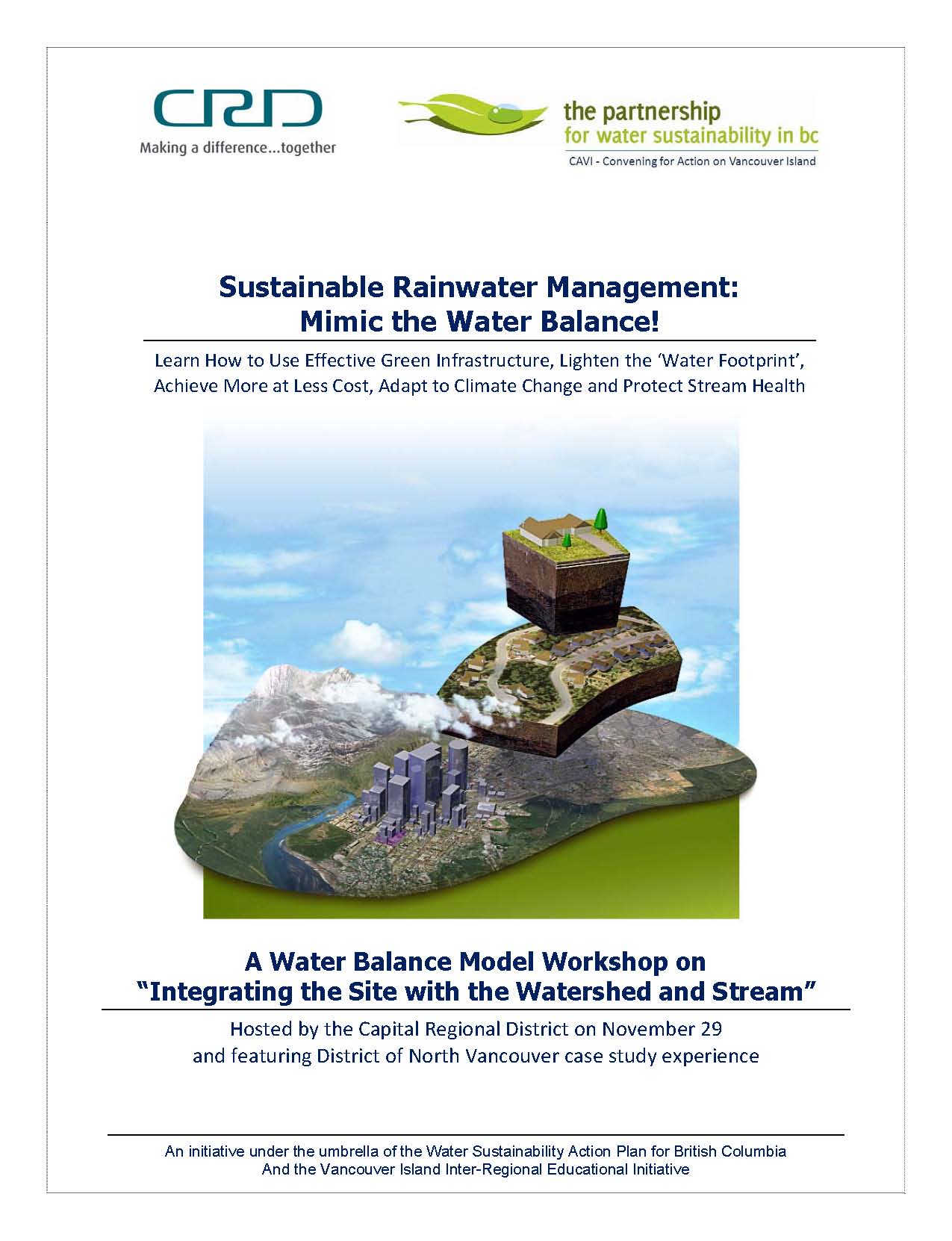Sustainable Rainwater Management: Capital Regional District hosted third in 2012-2013 series of “Water Balance Model Training Workshops”
Note to Reader:
In 2011, the Partnership for Water Sustainability in BC rebuilt the Water Balance Model on a new platform. Quicker and cleaner to use, the rebuilt version now has launch buttons at three scales of investigation; SITE, NEIGHBOURHOOD and WATERSHED. In conjunction with the re-build, the Partnership implemented an outreach, education and training program.

Richard Boase (standing on left) and Jim Dumont (standing on right) provided guidance in how to apply the Water Balance Model Express
Workshop Showcased Green Infrastructure Practices that Reduce a Community’s ‘Water Footprint’
In November 2012, the Capital Regional District (CRD) hosted a training workshop that demonstrated how to use the Water Balance Model Express for Landowners and Drainage Infrastructure Screening Tool. The 3-person workshop team was led by Kim Stephens, Executive Director for the Partnership for Water Sustainability in BC. Jim Dumont explained the technology and applied science behind the Express and Screening Tool. Richard Boase shared District of North Vancouver experience in applying these tools to support land development and infrastructure decisions.
Water Balance Model Express
“The Water Balance Model Express for Landowners represents a bold leap forward in the way it strips the problem to its essence. It is an accessible, affordable and effective  tool. The Express solves the vast majority of common problems faced by a homeowner exploring ways to implement rainfall capture in accordance with a watershed plan, without requiring use of tools designed for more complex situations,” states Dr. Charles Rowney, the internationally recognized Scientific Authority for the Water Balance Model Partnership.
tool. The Express solves the vast majority of common problems faced by a homeowner exploring ways to implement rainfall capture in accordance with a watershed plan, without requiring use of tools designed for more complex situations,” states Dr. Charles Rowney, the internationally recognized Scientific Authority for the Water Balance Model Partnership.
Drainage Infrastructure Screening Tool
“Reliance on complex computer models and inflexible application of design standards may be having an unintended consequence. To help local governments make informed  decisions AND achieve more at less cost, the Water Balance Model Partnership has developed a web-based Drainage Infrastructure Screening Tool. This enables local governments to undertake drainage system capacity analysis without the need for intensive and expensive modelling of the storm sewer system,” stated Ted van der Gulik, Chair. Water Balance Model Partnership.
decisions AND achieve more at less cost, the Water Balance Model Partnership has developed a web-based Drainage Infrastructure Screening Tool. This enables local governments to undertake drainage system capacity analysis without the need for intensive and expensive modelling of the storm sewer system,” stated Ted van der Gulik, Chair. Water Balance Model Partnership.
Workshop Relevance to CRD’s Integrated Watershed Management Implementation Strategy
“The Capital Regional District hosted the workshop because it informs and supports the goals of the region’s Integrated Watershed Management Implementation Strategy,” stated the CRD’s Dale Green. He is Program Manager of the Stormwater, Harbours and Watershed Program.
 Moving to a watershed-focused program is allowing the CRD to support the municipalities and electoral areas with new strategies for environmental protection, including an increased focus on dealing with watershed stressors near the source rather than at the infrastructure or receiving environment level.”
Moving to a watershed-focused program is allowing the CRD to support the municipalities and electoral areas with new strategies for environmental protection, including an increased focus on dealing with watershed stressors near the source rather than at the infrastructure or receiving environment level.”
“Additionally, the strategy supports efforts in watersheds that cross municipal boundaries and provides guidance towards measuring watershed and receiving environment health to better assess program efforts.”
“Local governments have many competing priorities and everyone is challenged to achieve more with the same resources in order to reduce risk, improve watershed health and comply with regulatory requirements.”
“The web-based Express and Screening Tool will help municipalities in managing rainwater effectively and affordably, while collaborating in a watershed sustainability context,” concluded Dale Green.
Workshop Two-Part Structure
“The workshop was a one day, two-part session that could be attended as either a full- or half-day. The morning segment provides information about the tools, and how they have been successfully applied in other jurisdictions. The afternoon was a hands-on l earning opportunity in a computer lab setting. Representatives from 11 local governments attended,” reports Brianne Czypyha, CRD Environmental Science Officer.
earning opportunity in a computer lab setting. Representatives from 11 local governments attended,” reports Brianne Czypyha, CRD Environmental Science Officer.
“The morning was designed to provide everyone – from general managers to technicians – with a common understanding of the WHY, WHAT and HOW of better delivering on regulatory objectives and compliance.”
“The web-based Water Balance Model Express and Drainage Infrastructure Screening Tool will be especially useful for municipalities who are encouraging sustainable rainwater management practices in their communities.”
Collaborative Initiatives will Help Local Governments Better Deliver on Regulatory Objectives & Compliance
“Integrate the Site with the Watershed and the Stream. Protect stream health. In British Columbia, the Ministry of Environment’s renewed emphasis on rainwater management is a driver for the Water Balance Model Express for Landowners,” states Kim Stephens.
 “The patterns of development and growth in BC stress fresh and coastal waters in ways that, in sum total, are particular to this region. It is crucial that we look clearly at this picture, understand what is needed, and develop technologies that fit those circumstances,” explains Dr. Charles Rowney.
“The patterns of development and growth in BC stress fresh and coastal waters in ways that, in sum total, are particular to this region. It is crucial that we look clearly at this picture, understand what is needed, and develop technologies that fit those circumstances,” explains Dr. Charles Rowney.
“The Water Balance Model Express for Landowners is an example of this kind of thinking. It solves the vast majority of common problems faced by a homeowner exploring ways to implement rainfall capture in accordance with a watershed plan, without requiring use of tools designed for more complex situations.”
“The Express integrates three pre-set performance targets using a methodology developed by Jim Dumont, Engineering Applications Authority for the Express. These are watershed-specific and link rainfall to stream health. This frees users to focus solely on selecting rainfall capture measures that will achieve their specific pre-set targets for storage, infiltration and stream baseflow sustenance. The underlying technical approach is precedent-setting.”
“The interface is also innovative. It uses modern web technologies to guide the landowner through a simple and visually oriented set of sizing options, with outcomes displayed in real time. It is colourful, effective, fast and no more complex than the dash board of a typical car, stripping the problem down to a few sliders and gauges. We think both homeowners and professionals will find this interactive tool to be an efficient and enjoyable way to rapidly test alternative rainwater control types and sizes,” concludes Dr. Rowney.
To Learn More:
To download the invitation circulated by the CRD to its municipal members,click here.
To download a copy of the Workshop Flyer, click on Sustainable Rainwater Management: Mimic the Water Balance!
To download a copy of the Workshop Handout, click on Learn How to Use Effective Green Infrastructure, Lighten the ‘Water Footprint’, Achieve More at Less Cost, Adapt to Climate Change and Protect Stream Health
To visit the workshop homepage, click on Capital Region Water Balance Workshop.






